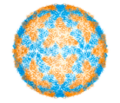Golden shiner virus
Golden Shiner Virus (GSV) is a significant pathogen affecting the Golden shiner (Notemigonus crysoleucas), a fish species commonly used as bait in North America. This virus poses a substantial threat to aquaculture, particularly within the baitfish industry, due to its high mortality rates and rapid transmission. Understanding GSV, its transmission, symptoms, and management strategies is crucial for preventing outbreaks and minimizing economic losses.
Etiology
GSV is classified within the family Iridoviridae, a group known for containing large, icosahedral, double-stranded DNA viruses. The virus is specifically identified by its unique genetic markers and morphology under electron microscopy. It has a broad host range within freshwater fish species but is notably pathogenic to the Golden shiner.
Transmission
Transmission of GSV can occur through both horizontal and vertical pathways. Horizontally, the virus spreads through direct contact with infected fish, contaminated water, or equipment. Vertically, it can be passed from parent fish to their offspring through the eggs. Environmental stressors, such as overcrowding and poor water quality, can exacerbate the spread and severity of the disease.
Symptoms and Diagnosis
Infected fish may exhibit a range of clinical signs, including lethargy, anorexia, erratic swimming, and increased mortality rates. Subclinical infections are also common, with fish appearing asymptomatic. Diagnosis of GSV involves a combination of clinical signs, histopathology, and molecular techniques such as polymerase chain reaction (PCR) to detect viral DNA.
Prevention and Control
Preventative measures are paramount in managing GSV outbreaks. These include maintaining optimal water quality, reducing stress through proper handling, and implementing biosecurity measures to prevent the introduction and spread of the virus. Vaccination and selective breeding for resistance are areas of ongoing research.
Economic Impact
The economic implications of GSV outbreaks are significant, particularly for the baitfish industry. Losses stem from direct mortality of infected stocks, costs associated with disease management, and potential restrictions on the movement of live fish.
Research and Future Directions
Research on GSV is focused on understanding the virus's pathogenesis, developing reliable diagnostic tools, and creating effective vaccines. Advances in genetic resistance and improved management practices offer hope for mitigating the impact of GSV on aquaculture.
Transform your life with W8MD's budget GLP-1 injections from $125.
W8MD offers a medical weight loss program to lose weight in Philadelphia. Our physician-supervised medical weight loss provides:
- Most insurances accepted or discounted self-pay rates. We will obtain insurance prior authorizations if needed.
- Generic GLP1 weight loss injections from $125 for the starting dose.
- Also offer prescription weight loss medications including Phentermine, Qsymia, Diethylpropion, Contrave etc.
NYC weight loss doctor appointments
Start your NYC weight loss journey today at our NYC medical weight loss and Philadelphia medical weight loss clinics.
- Call 718-946-5500 to lose weight in NYC or for medical weight loss in Philadelphia 215-676-2334.
- Tags:NYC medical weight loss, Philadelphia lose weight Zepbound NYC, Budget GLP1 weight loss injections, Wegovy Philadelphia, Wegovy NYC, Philadelphia medical weight loss, Brookly weight loss and Wegovy NYC
|
WikiMD's Wellness Encyclopedia |
| Let Food Be Thy Medicine Medicine Thy Food - Hippocrates |
Medical Disclaimer: WikiMD is not a substitute for professional medical advice. The information on WikiMD is provided as an information resource only, may be incorrect, outdated or misleading, and is not to be used or relied on for any diagnostic or treatment purposes. Please consult your health care provider before making any healthcare decisions or for guidance about a specific medical condition. WikiMD expressly disclaims responsibility, and shall have no liability, for any damages, loss, injury, or liability whatsoever suffered as a result of your reliance on the information contained in this site. By visiting this site you agree to the foregoing terms and conditions, which may from time to time be changed or supplemented by WikiMD. If you do not agree to the foregoing terms and conditions, you should not enter or use this site. See full disclaimer.
Credits:Most images are courtesy of Wikimedia commons, and templates, categories Wikipedia, licensed under CC BY SA or similar.
Contributors: Prab R. Tumpati, MD

